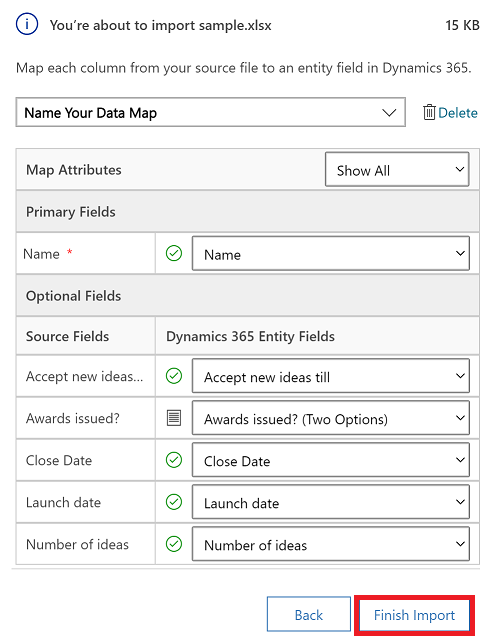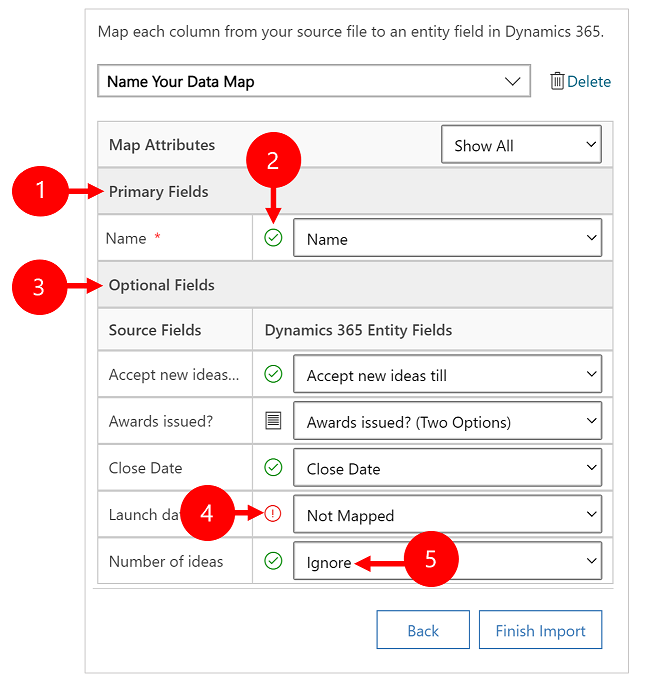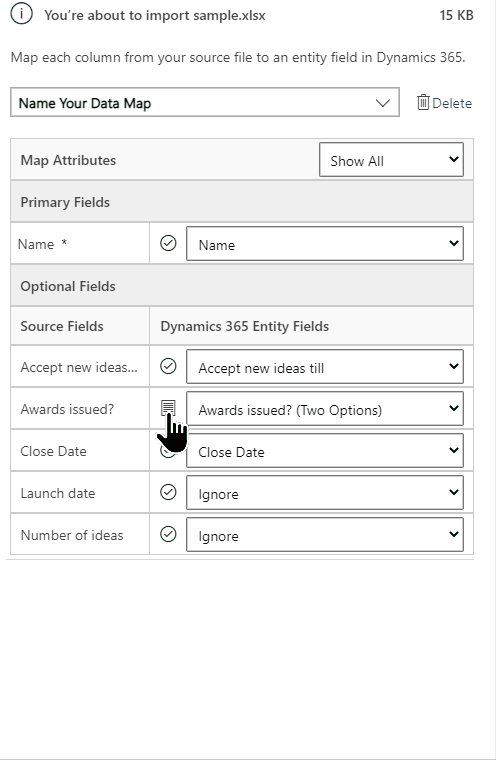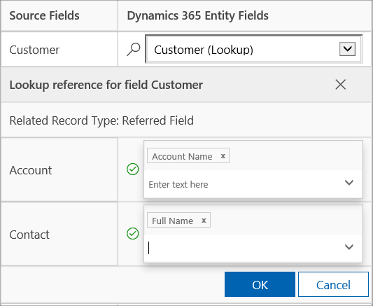How to import data
Import data that's stored somewhere else into your model-driven app using the import feature in Power Apps.
Every table has required columns that must exist in your input file. It's recommended that you download an Excel template, add your data, and then import the file to your app. The template saves time and effort. Don't add or modify columns in the template to avoid issues during the import.
Before you import a file make sure the column headings match the column names in your app. During the import process, the system will try to map the column names from your input file to the column names in the app. If they don't match, then you'll have to manually map the fields or you may run into issues during the import process.
If you're an advanced user and know the required columns for a given Dataverse table, define your own Excel, CSV, or XML source file and then follow the steps in this article on how to import data to your app. These file formats are supported:
- Excel workbook (.xlsx)
- Comma-separated values (.csv)
- XML Spreadsheet 2003 (.xml)
The maximum file size allowed for .zip files is 32 MB. For the other file formats, the maximum file size allowed is 8 MB.
Download an Excel template
To avoid mapping issues, it's recommended that you use an Excel template that you can download from your app. Once the template is downloaded add your data and then import the file back to your app. Remember don't add or modify columns in the template to avoid issues during the import process.
Open your app and from the left nav select a table.
On the command bar, select Excel Templates > Download Template.
Select the table type and view to download or select Edit Columns and choose the rows to include in the template.
Select Download.

Import your data
Use the template that you downloaded in the previous step (modified with your data) and import the file to your app.
Open an app and from the left nav select a table.

On the command bar, select the file type to import from:
- Import from Excel: Select Import from Excel if you're using an Excel template.
- Import from CSV
- Import from XML

Select Choose File and browse to the folder where the file is saved. Select the file, select Open, and then select Next.
Tip
You can only import one file at a time. To bring in more files, run the wizard again.
Select whether to Allow Duplicates or not. More information, see Set up duplicate detection rules to keep your data clean.
For CSV and XML files (skip this step if you're importing an Excel file):
For a CSV file: Select the drop-down list and select the data delimiter and field delimiter that's used for the CSV file.
For CSV or XML file: If you have an alternate key defined, select it from the alternate Key drop-down list. The alternate key is used to uniquely identify and update rows during import. More information: Define alternate keys to reference rows.

Select Review Mapping and verify the columns (fields) are mapped correctly. If everything looks good, select Finish Import.

Select Track Progress to see the progress of the import.

Review mapping
When you import a file, it's important to review the column headings and verify that they match the columns (fields) in your app.

Legend:
Primary Fields: Shows all the required columns for the table that must be mapped for the data to be imported successfully. If the column headings of your source file match the column display names, these columns will be automatically mapped.
Mapped columns: Correctly mapped columns will be shown with a green check mark.
Optional Fields: These are optional column headings in your source file. If the column headings match the column display names, the columns will be automatically selected in the corresponding drop-down lists.
Unmatched columns: If the column headings don't match, the unmapped columns will be shown with a red exclamation point. To map the column correctly, select a column to map to the unmapped column heading of your file.
Ignore (For Optional Fields only): Choose Ignore from the drop-down list. Data from ignored columns won't be imported into your app.
Option set
If any column in your source file includes a fixed set of values, you must map the column to a column of type Option Set. A column of this type has values such as Yes and No or Low and High.
To do this, select the  button next to the option set column, select the values, and then select OK.
button next to the option set column, select the values, and then select OK.

The option values drop-down list combines the values available in the incoming file with those already in your app. For example:
- Values in import file: Low, High
- Values already in your app: Cold, Warm, Hot
- Resulting target values: Cold, Warm, Hot, Low, High
After import, the import wizard will add all mapped values in your app, but will drop unmapped values from the import file that aren't yet in your app. For example, you could map the "Low" source value to the "Cold" target value, but map the "High" source value to the (new) "High" target value. Based on these mappings, the import wizard creates "High" as a target value in your app. It does not create "Low" as a target value in your app because you didn't map any source to this target value.
Note
You can also map a column in your source file to a column of type "Two Options" and "Multiselect Option Set" (where a column can have multiple values). You must map each Source Option Values to the items in the Dynamics 365 Option Values list. When mapping to a column of type "Multiselect Option Set," if your source file includes values that aren't available in your app, new values won't be created in your app.
Map lookup columns
If some data in your source file references other existing rows in your app, you must map the column in the source file to a lookup column in your app.
For example, you might want to import a file named Leads.csv, which contains customer rows. The Customer column in Leads.csv contains the associated account or contact data. To map this, select the Lookup Reference button next to the lookup column. The Lookup Reference section opens and lists the tables related to the current table.

For each table, select the columns to search during import to retain the relationships between the rows, and then select OK.
Save mapping settings
To save the mapping settings for next time, enter a name in the Name your data map box. This way, the next time you import a similar set of data, you'll be able to use the same mapping.

See also
Feedback
Coming soon: Throughout 2024 we will be phasing out GitHub Issues as the feedback mechanism for content and replacing it with a new feedback system. For more information see: https://aka.ms/ContentUserFeedback.
Submit and view feedback for